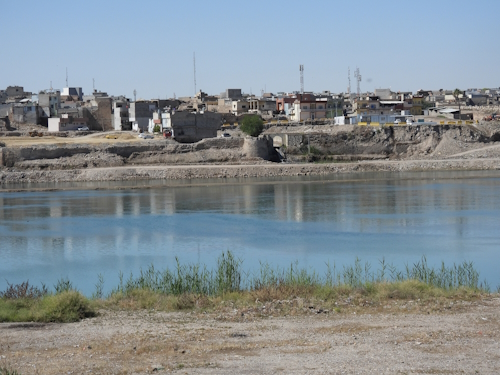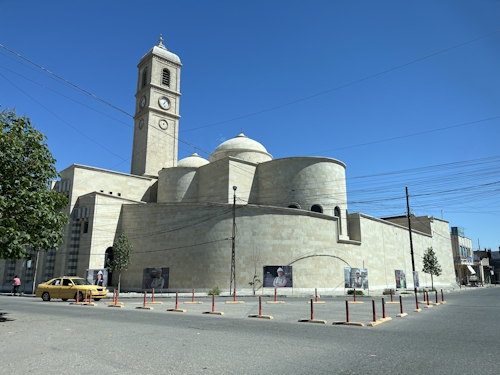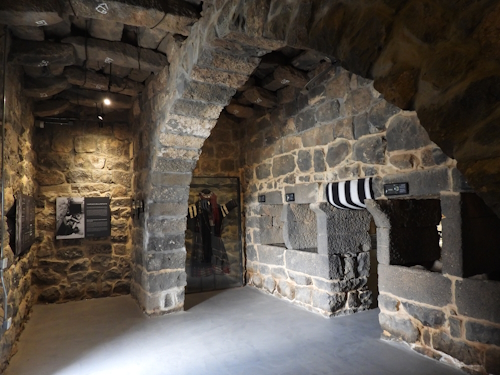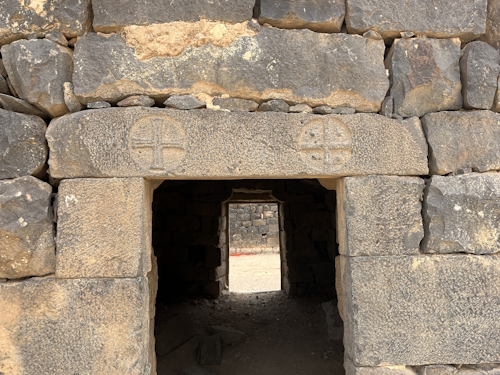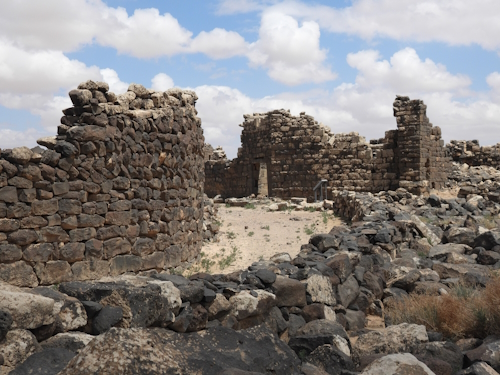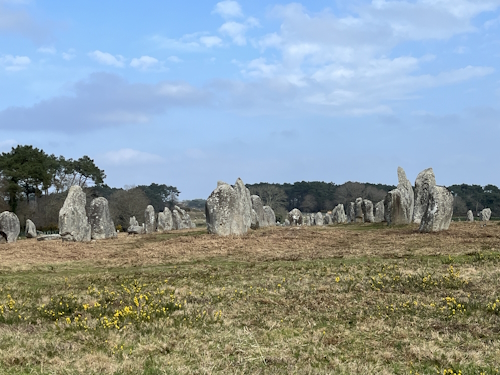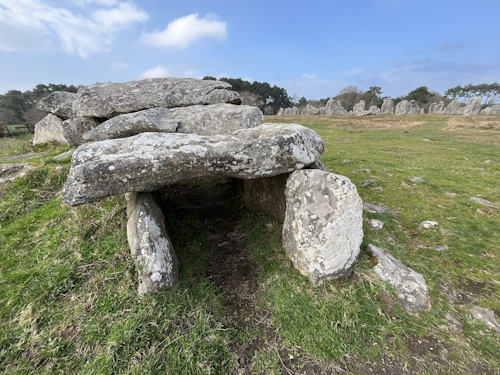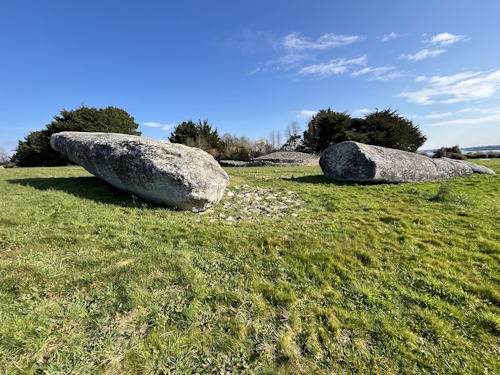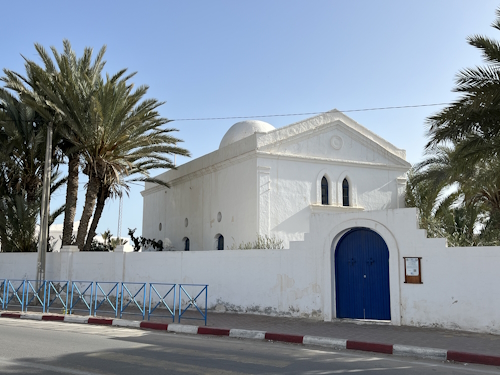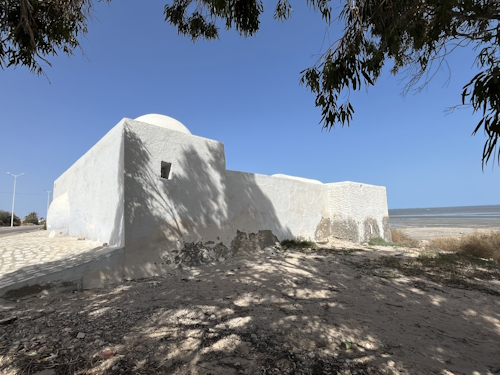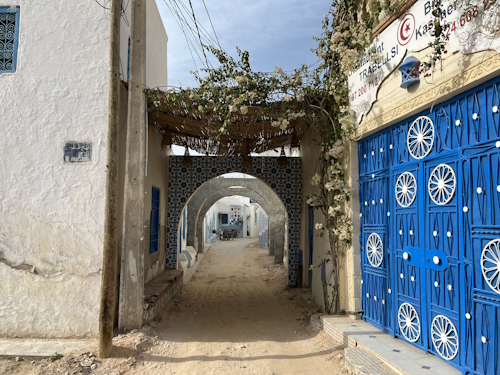Blog Countries
Top Tips for Travelling to Iraq
My first visit to Iraq was in 2014, when I covered semi-autonomous Iraqi Kurdistan. In April 2025, I went to what in tourism is known as ‘Federal Iraq’ (although that would be a more appropriate name for the entire country, including the Kurdish governorate). As it covers the major sites of Ancient Mesopotamia, it is definitely the most interesting part and it holds 5 out of the country's 6 WHS. Herewith are some tips for travelling to Iraq as a WH Traveller.
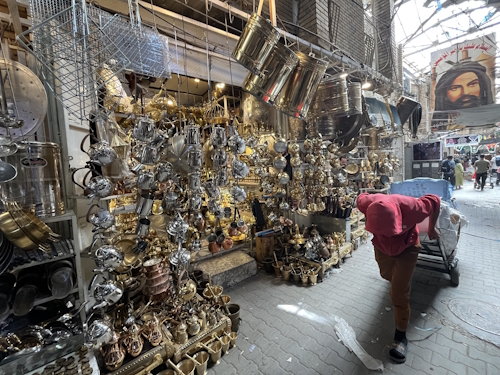
1. Don’t expect it to be pretty
Most of it is a typical flat Arab desert landscape, littered with plastic waste. The monuments generally also lack the refinement and colour of those in neighbouring Iran. Unless roadside portraits of Shia clerics particularly enamour you, your best bet for beauty are the statues and sculptures in the National Museum in Baghdad.
2. The safety situation normalizes rapidly
Many western countries (such as Germany, Australia, USA) still raise a red flag for all travel to Iraq, although the UK, for example, has lowered its warnings for the southern areas, including Baghdad, Babylon, Najaf, and the Marshes. On the ground, it all feels calm and safe and the people are friendly to foreigners, no matter where they are from. Nowhere does it feel oppressive, and you can walk the streets freely. Our local guide said that it had been like this for about 4-5 years, and that it normalizes more and more every quarter. The only reminder of worse times is the high number of checkpoints along the roads between governorates and while entering cities. These do slow you down a bit, but we passed all without incident within a few minutes and they never did look at us individually (just a chat with the driver/local guide and browse through a selection of the passports).

3. There’s a lot of potential for more WHS
The coverage of the most important periods in Iraqi history is fairly balanced, but 6 WHS isn’t a lot for a country of its size and importance (Iran has 28 WHS!). I think Iraq can easily have 8-10 more. Ordered by historical period, candidates are:
- Prehistory (0): the Shanidar Cave as an important Neanderthal site (one of the largest single-site collections of Neanderthal fossils ever found), not on T List but also a prominent role in the Iraq National Museum.
- Ancient Mesopotamia (3): Sumerian at Ur/Uruk, Assyrian at Ashur, Neo-Babylonian at Babylon. Well-covered, but as it is Iraq’s unique specialty, maybe Nineveh, Nimrud or Nippur could be added as well (though these are in a poor state).
- There’s nothing from the 2 centuries-long rule of the Persian Achaemenids: worth a mention here are the rock-cut tombs of Qizqapan in Kurdistan region.
- Classical Antiquity (1): the Parthians at Hatra, but there’s none from the Sassanids, this should be covered by Ctesiphon (not on T List).
- Islamic Conquest (1): Abbasids (Samarra), could/should have Old Baghdad too.
- Turkic and Mongol dynasties (0): the TWHS Old City of Mosul should cover this, as its landmark mosque is from the Turkic Zengic dynasty.
- Ottoman Empire (1): Erbil WHS has an Ottoman street plan. The Baghdad and Mosul sites also have significant Ottoman remains.
- 20th century (0): could be covered by some sites in continuous use, such as the Yezidi Lalish Temple or the Wadi Al-Salam Cemetery in Najaf (both on T List)
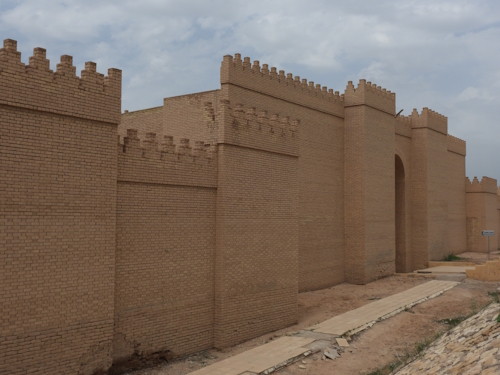
4. Other factors have caused more lasting damage than the 2003-2017 wars
Any damage from the 2003 Invasion and the subsequent Iraqi Civil War on the Iraqi (T)WHS now seems to have been erased or at least patched up as best as they could. Even the impact of the ISIS iconoclasts in the end was fairly limited: only Mosul and Nimrud still show the signs. Still, the state of conservation of all sites leaves a lot to be desired. A particular Iraqi problem is what to do with the unbridled reconstructions of poor quality, which were popular during the Saddam era. ICOMOS seems to suggest that removing them would be best in the end, but that would be a hell of a job. Babylon (photo 3) is covered with them and also at other sites, they are prominently visible. I also found it remarkable how little excavation work has been done at virtually all sites. Site interpretation is generally quite poor too, so better to read up beforehand.
Els - 4 May 2025
Comments
jonny 8 May 2025
I miss jonny
Blog TWHS Visits
Old City of Mosul
The northern city of Mosul is the odd one out among the Iraqi (T)WHS. On the one hand, it is probably the one most severely damaged during the recent conflicts (though nearby Nimrud has been hit hard as well). On the other hand, it is the only one that has been subject to a full-scale international rescue mission, which has also brought in internationally accepted restoration and conservation standards.
The Old City of Mosul stands for a thus far unrepresented part of Iraqi history: that of the Turkic-Mongol invasions (though a nomination will also include its Ottoman remains). The Turkic Zengid Dynasty ruled the area of northern Iraq and Syria from Mosul from 1127–1222. The city, located along the major trade routes of the time, was known for its metal craftsmanship and miniature painting. The main monument left from this period is/was the Al-Nouri mosque and its leaning minaret.
Unfortunately, it was exactly this mosque that was blown up by ISIS during their retreat from Mosul. Their black flag had been flying from the minaret since Abu Bakr al-Baghdadi claimed the Caliphate from here in 2014. After losing the Battle of Mosul in April 2017, they blew it up with explosives in a “final act of angry defiance”.
The first impression of the Old Town in April 2025 is still one of devastation (photo 1). The area along the West Bank of the Tigris is in total ruins and part of it has already been bulldozed. The narrow alleyways of the Old Town had been used to fight a guerrilla-style war during the Battle of Mosul. This is where the Ottoman-era quarter is – probably more so in layout than authenticity of the buildings, as most looked not that old to me (plenty of concrete). All standing buildings have been cleared of explosives, but there seems to be no fixed plan for what to do with them.
The Al-Nouri mosque lies a few blocks more “inland” in the core of the city and it was its main mosque. The mosque complex is still fenced off like a construction site, but we were allowed to enter after registering our names on a list with site security. The minaret has now been fully restored, in all its former leaning glory, “like a man bowing”. It’s also impressively tall. The local community had been polled on whether to rebuild the minaret as it was, or leave it in ruins to remember what happened; 94% of the population wanted the monument as it was before. They’re still working on the mosque itself – the interior of the building (which wasn’t as “authentic” as the minaret anyway, as it had been rebuilt many times) still needs a lot, though the massive marble columns are of interest. They’ve also stumbled upon older versions of the mosque underneath and will make those findings visible as well.
Another notable aspect of Mosul has always been the co-existence of different cultural groups. There are several churches in the city center, of different denominations. Like the Al-Nouri mosque, the Notre-Dame de l’Heure convent and the Tahera Church are part of the ‘Revive the Spirit of Mosul’-project. Kick-started with a donation of 50 million USD by the UAE in 2018 and a further 48 million USD by the EU, UNESCO, Iraq's culture ministry, and ICCROM work together in restoring these monuments. The Dominican Notre-Dame de l’Heure convent looks as good as new (photo 3) and work on the Tahera Church has just been completed as well (we weren’t allowed to enter that one as the priest was afraid we would stain the carpets before the upcoming grand opening). The Dominican convent is quite impressive, with stained glass windows and a rooftop from where you’ll get good city views. Religious activity is only occasional – there are hardly any Christians left in Mosul city, although there are more in villages in the surrounding Nineveh Governorate. The Revival Project also tries to revitalize a small heritage quarter with a museum and some Ottoman mansions.
Before I read up on it, I hadn’t been aware how big the ‘Revive the Spirit of Mosul’-project is in a UNESCO context – it is said to be the largest initiative carried by UNESCO since the Abu Simbel move in the 1960s. Funding has reached 115 million USD. So, good news for Mosul, and they may even have it listed as a WHS in a couple of years. But the cynic in me wonders about whether the Shia-dominated parts of Iraq aren’t worthy of foreign investments either. Mosul is a purely Sunni city, which probably explains why the UAE were so quick to throw money at it. The EU has listed anti-terrorism and the coexistence of different religions as two of the main reasons to support the project so generously – it provides lots of local jobs and gives the place its pride back.
Els - 27 April 2025
Blog Connections
One Million - Updated
Our connection ‘One Million Visitors or More’ is popular: it links 107 WHS that are visited yearly by large numbers of tourists. Looking at the years given with the explanations, it seems that the last major update of this list was done between 2015 and 2017. It did not make much sense to update it during the COVID years (2020-2022), but now, in 2025, with data across the ‘normal’ years 2023 and 2024 available, I have gone for a full makeover.
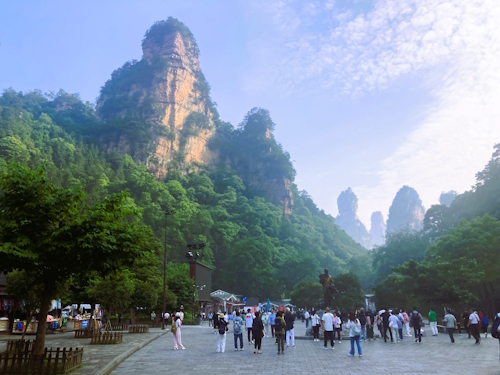
Update process
Out of the 107 connected sites, I found adjusted numbers from the ‘After COVID’-era for 90 WHS. Unfortunately, often, there is very little precise info available. A notorious example is the Cologne Cathedral, whose official website has shown ‘6 million’ for ages. And despite the country’s love for administration, data on Indian WHS are hard to get. On the other side of the spectrum, the UK publishes nice statistics every year via the Association of Leading Visitor Attractions (ALVA).
In the connection descriptions, I have kept the old data as well, as it is interesting to see the trends over time (as long as they stay over one million visitors).
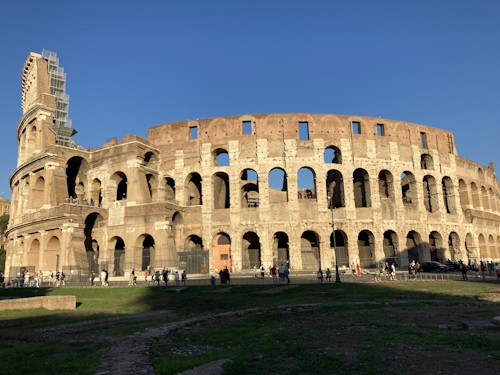
Findings
When we compare the numbers pre- and post-COVID, the overall findings are that (a) the numbers have at least returned to the levels before 2020, and (b) most are in the same range or slightly higher than before.
Some other trends can be seen as well:
- European WHS do well; maybe European tourists stayed closer to home right after COVID?
- Several US WHS see lower numbers than before. Their cost may be an issue.
- The already very high numbers in China keep on growing and growing. Overall, the East Asian sites do well due to strong domestic tourism from their large urban populations. Photo 1 shows the entrance to Zhangjiajie NP (Wulingyuan) on a quiet morning.
- Türkiye does well also. Some sites grew due to reopenings (Selimiye Mosque), or the temporary free entrance to the Hagia Sophia after being considered a mosque again. The investments in big site museums also seem to pan out, as Troy is expected to rise beyond 1 million in 2025 as well. I wonder what the sharp rises in entrance fees over the years 2024-2025 will do.
We also have seen the introduction of daily visitor caps at these sites: Acropolis, Forbidden City (Imperial Palace & Beijing Central Axis WHS), Kulangsu, Mogao Caves, and West Norwegian Fjords.
One would expect lower numbers at the following sites that have been affected by conflict, war and other damage:
- Bagan (Myanmar) has seen an unexpected rise from 2 million in 2019 to 3.4 million in 2022, despite the military junta taking over in 2021 and the subsequent civil war.
- Shuri Castle, one of the Gusuku sites, burned down in 2019, but numbers have rebounded to 1.44 million in 2023 (1.8 million in 2015).
- The two main Russian tourist magnets, the Kremlin Musea and the Hermitage, have seen a drop from 2 to 1 million and 4 to 2.8 million, respectively.
- There are no new numbers for the Kyiv Cathedral and Lavra, but considering the conflict surrounding the Lavra, they probably will be lower than before.
Oddities are the two hugely popular local pilgrimage sites on the List: Pavagadh Hill in India (photo 3 shows the queue) and Adam’s Peak in Sri Lanka. Any numbers given here seem to be guesses, but crowded they certainly are.
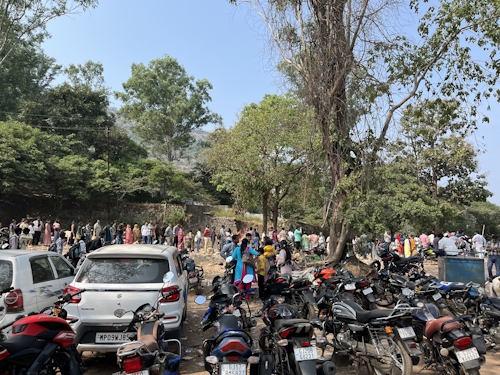
Risers, Fallers and New entries
The strongest risers are the Acropolis, from 1.475 million visitors in 2016 to 8.4 million in 2023, Versailles, from 7.5 to 15 million; Rome’s Colosseum from 6 to 12 million; and Istanbul’s Hagia Sophia from 3.7 million in 2019 to 13.6 million in 2022.
The only one I found falling below 1 million during this time frame is the Everglades: from 1.018 million in 2017 to 810189 in 2023. I also doubt the numbers of the Amphitheater of El Jem, since tourism to Tunisia has severely declined (but I could not find an updated source).
New entries since 2020 are the newly inscribed sites of Beijing Central Axis, the Getbol and Göbekli Tepe.
Els - 20 April 2025
Comments
Durian 20 April 2025
The free visa program of many countries in Asia especially China, Japan and ASEAN is causing a tourist boom in Asian markets.
Jay T 20 April 2025
Some of the sites around the Mediterranean could be seeing an increase in numbers due to the cruise industry. I also wonder how much airline layover deals factor into visitor numbers (i.e. tourists on Turkish Airlines spending time in Istanbul en route to their final destination).
Very interesting list. How many of the Top 100 members on this website have visited all 107 of these sites?
Blog WHS Visits
WHS #958: Umm Al-Jimāl
One of the aspects that make Counting WHS more difficult than Counting Countries or Counting Regions is that the List is infinite and it will require you to backtrack to specific areas, whereas for the other lists, one visit suffices. Surely, many WH Travellers will need to retrace their steps for Umm Al-Jimal: only 28 of us made it to this recent WHS, while nearby Jerash has been seen by 121 and Quseir Amra by 174. On my 2012 Jordan trip, I covered those two as well and even Azrak Castle TWHS, but I did not make it to Umm Al-Jimal: it seemed too nondescript for a detour, as are Pella and Gadara, which also lie in the same region north of Amman.
Despite its relative obscurity, Umm Al-Jimāl has been praised as “an archaeologist’s dream”. It’s not hard to take pictures here that would make it look like a Roman-Byzantine site, and the even earlier Nabataeans passed here too, but 90% of the site consists of vernacular architecture based on locally available and finely cut basalt stones. The site museum glorifies the “indigenous people [probably Arab nomads who settled down].. who continued their traditions and were no puppets of the various rulers”; the OUV is also solely based on the rural lifestyle of these Hauranian people. At the time, around 500-800 AD, Umm Al-Jimāl was a prosperous town based on agriculture and serving the next major city of Bosra (nowadays 80km away by car since you have to find a border post into Syria, but as the crow flies or the camel walks it is only 25km).
The archaeological site still requires no entrance fee and can be entered both via the south (where a friendly tourist police station is) and the northwest (adjacent to the central street of the modern town). The south is the main entrance, and the first stop here is the small site museum. It occupies a restored house typical for the area, built with sturdy black basalt stones to withstand the heat and with the horse stables inside (photo 1). In the museum collection, the multilingual inscriptions stand out, such as the Dushara inscription on a cult stone with text in both Greek and Nabataean.
The site map displays a route along 33 monuments scattered around this vast site. The trails have no signage, so you just go out and explore, which is also one of the charms of the place. If you see an information panel, the associated building must have something of interest and you are free to walk in among the rubble. There were no other tourists present when I visited, I only saw some locals taking a shortcut through the area.
A major remain from the Ancient Roman era is the huge reservoir, which is filled with rainwater again since the successful restoration of a water channel in 2019. This is an example of how the local Hauranian people used the site: they made good use of what was left behind from the Roman and Byzantine periods and incorporated it into their town. It can also be seen in the enthusiastic use of spolia in the domestic buildings: many houses are decorated with Christian symbols taken from the churches.
The most intact area is the western part that adjoins the modern town. Streets with rows of houses are still present, many with characteristic exterior staircases. Here, you’ll also find some of the major buildings such as the West Church (with the arches almost complete), the Cathedral and the Praetorium (possibly a Roman governor’s residence). It ends up at the Barracks.
Getting there on public transport
The site is reachable by public transport from Amman, although it’s somewhat cumbersome. First, you have to make your way to the city of Mafraq. I had read online that it is served by buses from Amman’s main North Bus Terminal, but there they told me that there are no direct buses. Instead, I was sent to a roadside minibus stop towards to the town of Al-Zarka. At its terminal, I caught a large bus filled with university students going to Mafraq. At the bus terminal in Mafraq, I changed once again to a minibus to Umm Al-Jimal. They will drop you off in front of the site entrance (after doing a confusing loop through the modern town of the same name).
On the way back, I took the same minibus back to the Mafraq bus terminal and found a ‘white taxi’ (or servis: a shared taxi) directly to Amman. Bus rides cost between 0.5 and 1 JD, and the shared taxi was 2.5 JD per person. I had a print with me with the names of Mafraq, Umm Al-Jimal and Northern Busstation Amman written in Arabic – that was very helpful. Total travel time, including some waits, was over 2 hours on the way up and 1.5 hours coming back.
Els - 13 April 2025
Blog Connections
A closer look at Rock Cut Art
Sometimes, while working on the website or prepping for an upcoming trip, I stumble upon an old Connection that hasn’t seen a lot of updates. Often, it’s so old that I hardly remember what it is about. Only Jurre may still know about its existence! While reading up on Göbekli Tepe, I wondered why we don’t have a connection for (bas-)reliefs since they are fairly common occurrences all across the world. It turned out that we are hiding them in a connection called "Rock Cut Art".
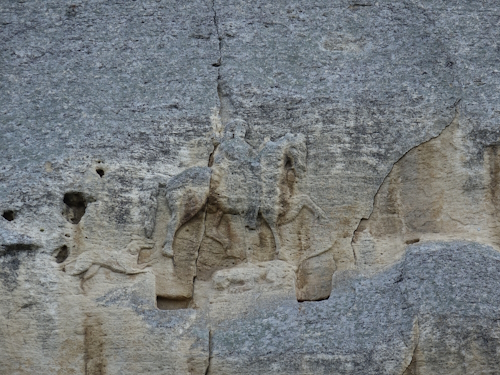
Definition issues
I found an e-mail from Solivagant dating back to 2009, where he highlighted that a clear differentiation was needed between the various cultural connections related to the use of “Rock”. We have:
- Monumental Monoliths: heavy pieces of rock, cut and detached from the living rock (including the obelisks of Aksum and Stonehenge).
- Cave Temples/Churches: built into natural caves with possible outside features and carving (such as those in Cappadocia).
- Rock Cut Architecture: structures carved in situ into “living rock”, not primarily based on natural caves (Petra, Ajanta, Ellora, etc).
- Petroglyphs: “line” drawings, patterns, or characters scratched, pecked, or etched into the rock (usually prehistoric, such as Valcamonica).
- And: Rock Cut Art: relief carving of rock which remains “in situ”(= attached to a solid background of the same material), but is not part of Rock Cut Architecture.
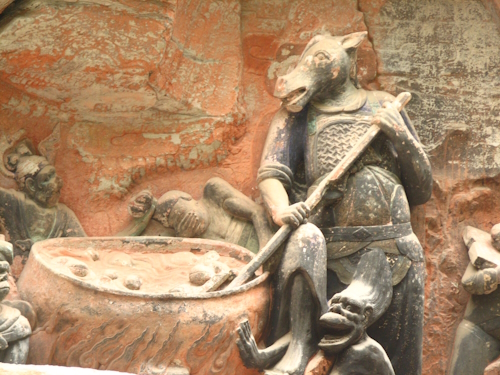
Types of Rock Cut Art
A closer look at the currently connected sites under Rock Cut Art reveals that even these 12 are not all that similar:
We have bas-reliefs depicting historical events, in the tradition of the Near East:
- Madara Rider: dating from the earliest years of the establishment of the Bulgarian state, the inscriptions around the relief are a chronicle of important events (photo 1).
- Sassanid Archaeological Landscape: Firuzabad, Fars and Bishapur have groups of Sassanian reliefs, the former including the oldest, a large battle scene.
We have sculpted stones in the Asian-Buddhist tradition:
- Polonnaruva (Gal Vihara): four rock relief statues of the Buddha, which have been carved into the face of a large granite gneiss rock.
- Mount Emei, including the Leshan Giant Buddha: the big Buddha.
- Dazu Rock Carvings: rock reliefs carved into the open rock faces (photo 2).
- Bamiyan Valley: the two monumental Buddhist statues that were carved out of a cliff.
- Gyeongju: 11 relief carvings, of which the most impressive is the Buddha Rock, a massive natural formation in the T’apkol Valley.
- Quanzhou: stone statue of Lao Tze.
And we have miscellaneous others that seem not to belong in this connection:
- Atapuerca (Galeria del Silex): considering the age of the site and the limited extent, I think these should be considered petroglyphs.
- Necropolis of Bet She'arim ("the mother of all menorahs", one of many seven-branched carved stone menorahs found throughout the site): this is interior decoration of rock cut architecture (man-made catacombs).
- Rock Art in the Hail Region (Shuwaymis, "detailed and meticulously pounded figures, of one or two metres are rendered 15–20 mm deep, as bas-relief figures"): usually described as petroglyphs (and are prehistoric).
- Champagne: a series of bas-reliefs by a 20th-century artist in the Pommery cellars, sculpted in the soft chalk of the chalk pits. A modern work of art?
How can we better clarify what this connection is about?
The Rock Cut Art connection has a couple of difficulties:
- The close resemblance to Rock Cut Architecture: although that one is aimed at monumental ‘buildings’ carved into the rock, they often contain a lot of Rock Cut Art as well (both inside and outside). So keeping this connection separate, it will never be a list of the best Rock Cut Art.
- It focuses on a specific technique, and it is hard not to mix it with a certain cultural context. Providing that context (such as the Near East bas-reliefs) may make it clearer.
- The recognizable feature of “relief” is not in the name; Wiki calls them Rock reliefs, and defines them as “generally fairly large, as they need to be to have an impact in the open air”. They include both the Near East and Asian variants.
In addition to “Is it carved out of a rock that is still in situ?”, we could ask for two other distinguishing features: does it show a certain craftmanship (a sculpture) and is it in the open air (aimed to impress passers-by)?
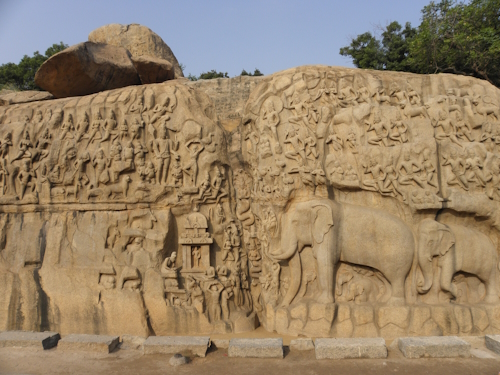
More Rock Cut Art
Based on the refined definition above, I think the following should be added:
- Bisotun: best known for its multilingual text, but it is also a monumental bas-relief that includes an image of King Darius “holding a bow as a sign of sovereignty, and treading on the chest of a figure which lies on his back before him”. It also has a Seleucid reclining Hercules of 148 BC with a Greek inscription.
- The 'Descent of the Ganges' at Mahabalipuram: a large 7th-century Hindu scene with many figures that uses the form of the rock to shape the image (this is a stand-alone monument, not a structural part of the architecture elsewhere on the site). (photo 3)
- Sigirya: the paws at the colossal lion gateway to the hill-palace.
- Hattusa: at Yazılıkaya, a series of reliefs of Hittite gods in procession decorate open-air "chambers".
- El Fuerte de Saimapata: we now have it as part of Rock Cut Architecture, but it is only the part with the intricate carvings that is carved directly out of the natural sandstone bedrock, not the buildings surrounding it.
- Sansa's Beopjusa Temple: a Rock-carved Seated Buddha (now in Rock Cut Architecture, but the temple isn't carved from the rock).
And coming back to Gobekli Tepe …. Here, the "very substantial number of low-reliefs and carvings, mainly of animals" were carved into the T-shaped megalithic pillars that were cut out of a rock elsewhere. So, not "in situ" and, thus, Out.
What do you think of this Connection? Should we rename it, split it, or include it with Rock Cut Architecture?
Els - 6 April 2025
Comments
Els Slots 7 April 2025
Thanks, all! I think it is best to keep the connection but rename it to "Stand-alone Rock Reliefs". I will adjust the list of connections accordingly. Further discussions can be had on the Connections Forum topic.
Frédéric M 6 April 2025
Could Petra qualify for this connection as well? I'm thinking of the camel caravan carved out the Siq. I think it checks all boxes.
Solivagant 6 April 2025
Wieliczka also has "standalone (albeit - subterranean) rock cut art"..... if we ensure that Mines are not included in "Rock cut architecture" (even though they may be "architected" from cutting rock) since the "main goal" of their creation was not to provide "functional space". The Champagne caves were developed initially as quarries for limestone
Jurre 6 April 2025
As I've more or less recently added Champagne to this connection, I did in fact know about this connection. And, just like you, I struggled a bit with the definition and the scope of the connection. A redefinition might help making the connection clearer.
First of all, I don't think it should be included in the "Rock Cut Architecture" Connection, as we have examples of rock reliefs that are not linked to rock-cut architecture.
As for the idea of a split: I'm not sure in which two separate categories we would split the connections. Stand-alone rock reliefs and those connected to rock cut architecture?
I think a redefinition of the connection is the better option. The concept of "Rock reliefs" should be included in the new name, as it distinguishes it from "Rock-cut architecture" and narrows the connection down to reliefs (both haut- and bas-reliefs) as an artistic expression, and distinguishes it from rock inscriptions and carvings (or petroglyphs).
As for what to add to the Connection name:
- If we opt for "Stand-alone", we exclude those reliefs that are part of rock-cut architecture, such as reliefs in rock churches or cave temples. This would exclue the Necropolis of Bet She'arim.
- If we opt for "Open air", then the subterranean rock reliefs, like those in the Necropolis of Bet She'arim and in the Champagne caves, are out.
Personally, I would definitely include the "stand-alone" concept, to exclude those reliefs that are part of rock cut architecture.
I'm in doubt about the "open-air", because I feel the reliefs in the Champagne caves tick several boxes of the rock relief characteristics. They are reliefs, forms of artistic expression. They are stand alone, and not part of rock cut architecture, because the caves were not created with an architectural design. And the reliefs are created to have an impact on the viewer, even if it is underground. It is clearly aimed at the many visitors of the champagne caves. It would make the champagne caves reliefs the exception that proves the rule, as the only subterranean one, but I do feel it ticks a lot of characteristics of rock reliefs.
Els Slots 6 April 2025
After a bit of offline discussion, I would propose a new name for the (separate) Rock Cut Art : "Stand-alone Rock Reliefs" or "Open Air Rock Reliefs"
Blog Travel in general
Travel Windows of Opportunity
I have been thinking lately about “Windows of Opportunity”, and whether they truly exist in a travel planning context. Windows of Opportunity are circumstances that suddenly present themselves and that may not happen again – so you need to react promptly to take advantage. This could be because an armed conflict ends or travel bans get lifted. For example: after the recent regime change in Syria, the Ancient Villages of Northern Syria have become accessible for the first time in about 14 years (trips to Serjella and Al-Bara are advertised). And a first international group visited North Korea in February 2025 after 5 years of Covid-closure.
I wonder however what these opportunities across a lifetime of WH Travel really mean. Should you go to Syria now in 2025 and put yourself on the waitlist for North Korea?
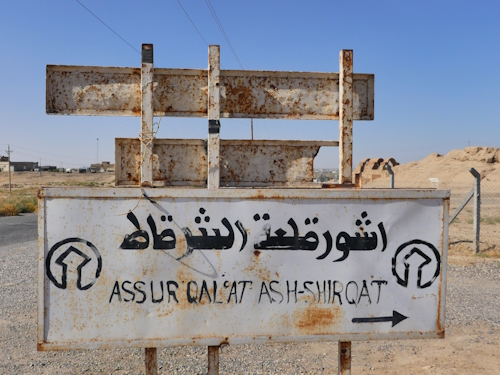
Windows of countries and sites
With the recent reopening of North Korea, every country is theoretically visitable again (though getting a tourist visa to Sudan or Niger may be tough). (Un)fortunately, as WH Travellers we need to get much deeper into a country than a border or a capital, so certainly not every WHS is visitable at the moment.
To gain an understanding of the impact of country and site "closures", let’s have a look at a few examples from the US naughty list:
- Iraq: Tourism to Iraq in general has almost always continued over the past difficult decades, but the numbers were mostly in Iraqi Kurdistan and at the Shia holy sites. Most WHS were off-limits during the US-led invasion of 2003 and its ISIS aftermath as they were right in the battle zones (it must be noted that 4 out of the 6 were only inscribed after 2003, so they wouldn’t have featured in WH travel plans anyway). Hatra and Ashur (Photo 1, credits to Clyde) took the longest to reopen; take a look again at how Thomas and Wojciech did it in 2021.
- Libya: The Libyan Civil War started in 2011, afterwards tourism hasn’t really returned although you can get in again since 2021, first on business visas and now on an erratic tourist visa process. All WHS are accessible, even the one in East Libya.
- North Korea: Group tours to its WHS were common until Covid hit (2020) and are expected to restart soon (though the border town that reopened in February 2025 unexpectedly closed again in March, according to Koryo Tours).
- Sudan: It has been on the US list since 2011, but its WHS have only been practically impossible to visit since the start of the Sudanese Civil War in 2023. It was a fairly mainstream destination before that (Photo 2 shows its excellent WHS of Meroë).
- Syria: The Civil War started in 2011; in 2015, “Iranian religious tourism was all that remained” (source). However, Damascus has always stayed open and in late 2016, many areas came back under central government control; 5 out of the 6 WHS have been visitable since, mostly on group tours, and, as mentioned above, in 2025, all can be done.
- Yemen: The WHS of Socotra and Shibam are accessible and have been so for years. Sanaa and other inland sites have been off-limits since the Houthi takeover in 2014.
And at some notorious single WHS:
- Afghanistan, notably the Minaret of Jam: located in a Taliban hotbed and probably unvisited by outsiders between 2001 and 2021.
- Democratic Republic of Congo, notably Virunga NP (Photo 3): The park is actually well-managed and has a good tourist infrastructure, but it lies in a highly flammable region with the presence of armed militia in and near the park, leading to frequent closures since its relaunch for tourism in 2014.
- Mali, Tomb of Askia: The area around Gao has had security issues since at least 2012 (it was even sketchy before), but Tripadvisor reviews show that people still trickled in until 2019.
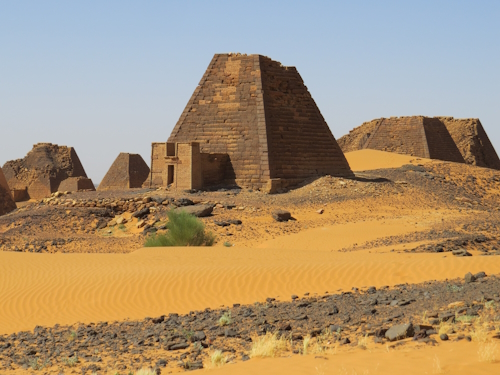
A need to act immediately or FOMO?
What we can learn from these examples is that inaccessibility caused by armed conflict and security issues generally doesn’t last for more than 5-10 years. Wars will eventually end, and tourist facilities are often quickly restored to their former glory, as everybody loves hard currency. Individual WHS, though, may stay out of reach for 10-20 years.
So I consider these not as true “Windows of Opportunity” as they do not generally open for a short period only. They are more like cyclic events with rather unpredictable timelines. You can be sure to get several of those opportunities during a travel life, even for countries with a problematic history. You can look at the Ancient Villages of Northern Syria from the perspective of “they have been inaccessible for 14 years”, but they have been open for 36 years as well during the past 50 years. 50 of our community members managed to visit during those earlier years.
Psychologically, the unpredictability of it all, the fear of “the window might close again on short notice”, pushes travellers into thinking these are once-in-a-lifetime opportunities. Hypes on social media strongly contribute to this FOMO.
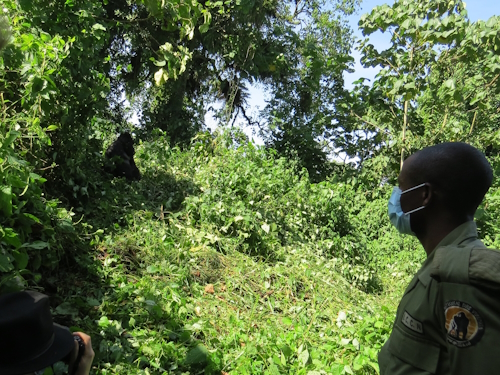
But keep in mind: When a country or region reopens after conflict, what will you encounter? Some people like to feel the optimism, witness history firsthand, or are lovers of Dark Tourism (seeing ruined cities, tanks left by the roadside, etc). But – especially keeping WHS in mind - how good will your visit be? The site may have been damaged during the war, may not have had its regular maintenance for years, site interpretation may have faded away, and the contents of the site museum are still packed away in boxes: it is probably not at its best.
My take on this is that I plan my trips in the order of the most appealing to me first. If a site I am especially attracted to has an “open window”, I will try to use it (as I did with Virunga). But I'd rather wait for Sanaa and a full Yemen trip being possible than rush to Shibam. There’s no harm in waiting a couple of years or even for the next cycle: the visitor experience may be much better.
Do you immediately act upon perceived Travel Windows of Opportunity?
Els - 30 March 2025
Comments
Wojciech Fedoruk 2 April 2025
Visiting sites after their reopening has its appeal. I like to be one of the first in the country recovering from disasters, to help them recover faster and to avoid crowds. But for some countries there is a risk that something will go wrong as the procedures are not set. Decision is taken balancing those two factors.
Blog TWHS Visits
2025 WHC: Carnac
The 2025 WHC will probably bring us the inscription of number 31 on our Missing List: Carnac. Two other 2025 nominations, Neuschwanstein Castle and the Minoan Palaces, are even higher on that list, so it might become a good year. Carnac is on the Tentative List as ‘Megalithic Sites of Carnac’, but the nomination has been renamed ‘Carnac and Shores of the Morbihan megaliths’. It has been put forward as a Cultural landscape and comprises four components with thousands of standing stones and tombs. The TWHS has a 100% recommendation after 24 votes from our community.
Carnac is a representative of the European megalithic tradition since the Neolithic, which also includes the Megalithic Temples of Malta and multiple sites in the UK and Ireland, such as Stonehenge and Brú na Bóinne. While at other subjects we’ve now ended up at very niche Tier 3 sites, Carnac undoubtedly is at Tier 1 among its peers. The nominated area covers 19,598 ha, about 4x as large as Stonehenge/Avebury and 6x the sites in Malta. Its oldest parts significantly predate Stonehenge and overlap with the earliest timelines of Newgrange and Ħaġar Qim.
What took France so long to put this forward? Breton nationalists may claim it was subordination by “Paris”, but it just has been a long and careful process which has been described on the official nomination website. The story already starts in 1980, when Carnac was part of France’s first Tentative List (we had overlooked that; I’ve now updated the Site History accordingly). It stayed there until a revised list was submitted in 1984. It reappeared in 1996.
Along the way, things evolved:
- Although the sites have been popular tourist and scientific destinations since the 19th century, it took until the 1990s for them to be properly managed and protected. The Table des Marchands (a major dolmen at Locmariaquer) was only excavated and restored in the early 1990s for example.
- The scope changed from Carnac Alignments only in 1980 to multiple megalithic locations in the Morbihan area in the current proposal.
- In 2005, major excavations brought to light connections between the elements.
- In 2011, an Association was created to streamline the nomination process.
- Thanks to its size, many actors are involved so it is a slow process to keep them all on board. Some opposition from landowners has been reported in the past.
I started my visit at the Carnac Alignments component. Winter is a good time to visit as you’re allowed on the trail amidst the stones by yourself and there will be much less visitors overall. Entrance to the Alignments is also free from October-March. I was lucky with the weather in early March: sunny, blue skies. I parked at the Ménec alignments and then continued on foot. Nothing can prepare you for the first sight of the endless rows of neatly arranged standing stones. I walked most of the ‘Alignments trail’ that connects Ménec with the other Alignments. You can also go by car as all have (smallish) car parks.
The best part I found at the start of Kermario Alignment: it’s here that the standing stones get taller, a complete dolmen can be found (Photo 2) and you get the iconic views of the rolling hills covered with rows of stones. Unfortunately, late afternoon isn’t the best time of day for pictures from the viewing tower at the opposite end as it faces the sun. I also think that on-site interpretation could be more informative, although I understand that not much is known about the idea behind the Alignments. Here and there you still see markers left by people who oppose the fencing of the whole area.
Two days later, I went to the Locmariaquer component. As the crow flies, it lies only 8 km from the Alignments, though it is a bit further by road. The main part here is a cluster of three major monuments. A 7 EUR fee has to be paid to enter, but they let you watch a good video that provides a bit more context. The individual monuments (a 140m long tumulus, a dolmen and the grand fallen menhir) have information panels as well. The ruins of the Grand Menhir (Photo 3) – fallen and broken, possibly due to an earthquake - are the most impressive. Parts have been reused as spolia in the dolmen at the site, they have some simple carvings as well (plus a bit of historical graffiti, I think I read "Gazelle"?).
Els - 23 March 2025
Comments
Els Slots 23 March 2025
No, nothing official. Just how I perceive for example Koh Ker - a Tier 3 Khmer site (I wrote in my review: "But we are getting to the Tier 3 sites now I think, with Angkor solely occupying Tier 1 of the Khmer sites and the current WHS Sambor Prei Kuk and Preah Vihear holding Tier 2.").
It has more to do with "importance" than our rating system which is a bit of a mix of quality of the visit and intrinsic quality of the site.
Astraftis 23 March 2025
Are the tiers an official classification? 😬 Or maybe something we can determine from the site's statistics!
Blog WHS Visits
WHS #957: Djerba
This is the first review of a visit to the Djerba WHS after its inscription. The site has received horrible reviews and an exceptionally low rating from our community, but I thought maybe it would all make more sense with the help of an OUV-frame. It’s about a dispersed but homogenous settlement and land-use pattern, characterized for example (but not limited to) self-sufficient rural communities with their own water supply, palm groves and tiny mosques. That’s why it includes 22 rather featureless and abandoned neighbourhood mosques.
For my visit, I tried to make a representative pick from the locations without having to rent a car. In the morning, I visited 4 components in and north of the capital city Houmt Souk. The medina of Houmt Souk is not a rural settlement, of course, but the trade town where everything ended up. Included is just a small zone (the old funduqs, the covered market, the Mosque of the Turks and St. Joseph Church; but not Borj El Ghazi Mustapha). It feels like a smaller version of the Medina of Tunis, and even in the early morning, it is all geared up to receive the French and German beach tourists. I then walked on to another component, the Church of St. Nicholas. A sign on the door says that it only opens on Thursdays from 10-13. The sizeable church (photo 1) can only be seen from the sidewalk across the street.
My next goal was the Mosque of Sidi Smain (photo 2), located along the Houmt Souk Corniche. This is one of the fortified mosques that formed a defense system along the coast. It lies across the street from a much prettier newer mosque with the same name, but it's only this old one that is inscribed. The last one on my morning visit was the Mosque of Sidi Zekri. This is situated in what is locally known as the ‘Tourist Zone’, although it’s more surrounded by wasteland and half-finished apartment buildings. It’s an underground mosque of an interesting design, but you cannot enter.
In the afternoon, I went southward, first by taxi to Erriadh. Formerly known as Hara Seghira, this was a major Jewish neighbourhood. It’s now a small town that tempts to attract the selfie crowd by creating “Djerbahood”, streets full of murals (photo 3). I had no idea where to find former Jewish landmarks such as the yeshiva described in the nomination file.
I then walked on for 10 minutes to reach the El Gribah synagogue. I had read online that there’s an entrance fee and that you have to show your passport, but nothing was asked for. Your bag has to go through a security scanner, but that’s all. Tunisian military personnel guard the entrance road since the site has suffered from several terrorist attacks over the past decades. You can visit the synagogue interior freely (it’s open daily, except Saturday, in the morning and late afternoon) and take pictures. Next to it lies a courtyard with rooms for Jewish pilgrims.
The Verdict
I tried hard to understand and like it more than the previous visitors did, but despite my research and having all documentation available, I came back even more confused. There may be a hint of OUV here or there (the sheer survival of the El Ghriba synagogue, the distinctive defensive lines formed by its coastal mosques), but what really put me off was the lack of interpretation on site. It also fails on almost all of the WHS Commandments. Djerba feels like a kid that has received yet another present (World Heritage status that was apparently so urgent it required an AB overrule) and never even unpacked it 2 years later.
The official number of locations is also confusing: I think we have another (the 23rd!) example of “Incorrect UNESCO 'Number of locations'” here. The site was nominated as a serial site of 31 components: the nomination dossier, the maps, and the ICOMOS evaluation all have 31. However, the UNESCO website currently shows 30 components, and the 2024 SOC report by Tunisia had 32. A “Zone Côtière inhabitée” was added in the northwest, while Khazroun / Sedghiene / Guecheine are seen as one by UNESCO where they are separate elsewhere. I don’t see a decision about a boundary modification, so my best guess is that the original 31 locations are still valid.
Practicalities
- If you want to see a fair number of the 30+ components, you’d need to rent a car or charter a driver for half a day as the sites are so scattered around the island and some are really remote. I did my 6 components on foot and by taxi. There are local buses as well, but they don’t run often. Taxis on Djerba are a good bet since they are plentiful, routinely use the meter and are cheap (about 3 EUR for a 15-minute ride). Bikes can be rented as well (and even quads!), but as with hiking, the sun is fierce and the distances are just a bit too long.
- I stayed overnight in the old center of Houmt Souk, in a nicely renovated townhouse (Dar Lola) in the core zone. Houmt Souk is mostly alive during the day when the day-trippers from the beach resorts come and visit. In the evenings, many restaurants were closed. Maybe this was also caused by it being Ramadan: so they did not bother to open at all if they couldn’t serve lunch. Shops and supermarkets remained open during the day.
Els - 16 March 2025
Blog WHS website
The First List
While adding the plaque photos, I came across this pretty marker sent to me by Sebasfhb and found at the Wieliczka Salt Mine. It shows the first 12 sites inscribed on the World Heritage List, so it is essentially a plaque for all WHS of 1978. It prompted me to look closely at how these 12 came to be the first.
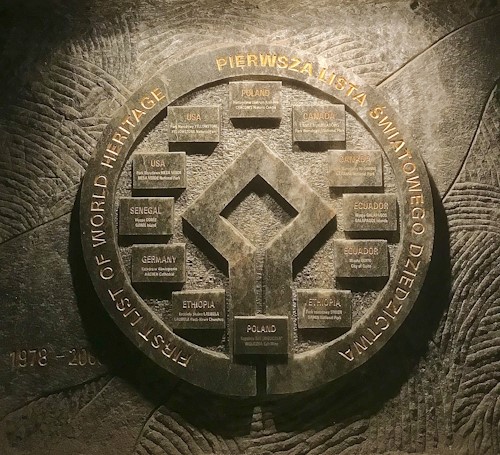
The nomination process in 1978
The World Heritage Committee (WHC) responsible for confirming the first list gathered in Washington DC, from 5-8 September 1978. The text of the World Heritage Convention itself was drafted in 1972. In 1977 there had already been a first WHC meeting, where they decided on subjects like amendments to the draft text of the WH convention and a printed form to be filled in for a nomination, and where the wish was expressed that “the World Heritage List should be exclusive and ..drawn up with extreme care”.
As was common in the first years, a Bureau Meeting preceded the WHC in June 1978. Here, a select group of 6 Members (Chair, Rapporteur, Vice-Chairs - together known as the "Bureau") reviewed the nominations received and the evaluations IUCN, ICCROM and ICOMOS presented. Their job was mainly to filter the nominations and to decide which ones would be brought to the table at the WHC in September. There was to be no substantive discussion on the individual sites during the WHC. The Bureau Members had little preparation as well: "some members of the Bureau had only received copies of the nominations that morning".
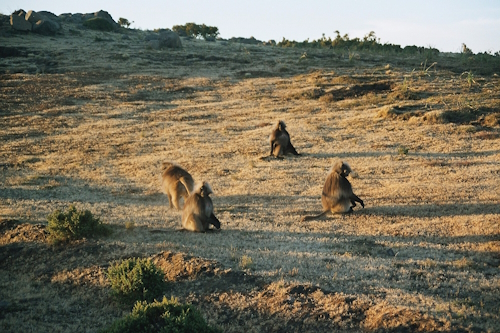
Sites that missed out
12 sites eventually got inscribed, but many more were proposed. Most were formally Re- or Deferred at the Bureau session for various reasons:
Auschwitz (Poland) fell victim to a hastily introduced new rule at the Bureau Meeting to only allow 2 nominations per year by a country. ICOMOS(!) chose the Wieliczka Salt Mine (the “most important”) and Krakow over Auschwitz. The latter got a Referral with a positive recommendation for 1979, when it indeed was inscribed. There was no word on the potential controversial status of this early “site of memory”.
Poland also “lost” Warsaw (needed further expert study to see if it met the criterion of authenticity) and Bialowieza (to await expert evaluation by the IUCN European Bison Committee) at that stage.
Regarding Djoudj (Senegal), additional information was requested about the possible dam construction “which would jeopardize site’s integrity”.
Lake Ichkeul (Tunisia) had a positive recommendation from the Bureau but was deferred eventually at the WHC, because requested additional information on water quality and assurances of continued supply had not come through. Also, for Zembra and Zembretta Islands National Park, there wasn't enough documentation for IUCN to perform a full evaluation. Two other nominations, Djebel Bou Hedma National Park and Djebel Chambi National Park, were withdrawn by Tunisia. The first one still lingers on its T List.
For Fasil Ghebbi, Gondar (Ethiopia), more information was needed. Eight other Ethiopian sites were deferred as well due to “inadequate documentation”. These were: Lower Valley of the Awash, Adulis, Tiya, Melka-Kontoure, Matara, Aksum, Yeha, Lower Valley of the Omo. It is remarkable to see that 75% of Ethiopia’s current WH List of 12 was already proposed so early. From the ones not inscribed later on, Adulis and Matara are now part of the country of Eritrea (and not on its T List), and Yeha has reappeared on Ethiopia’s T List in 2020.
Syria put in a request for funding for the sites of Damascus, Aleppo, Bosra and Palmyra, but did not submit nomination files. The 4 sites did get official IDs, though: 20, 21, 22 and 23, respectively. They kept those til the inscription years later (Aleppo only in 1986).
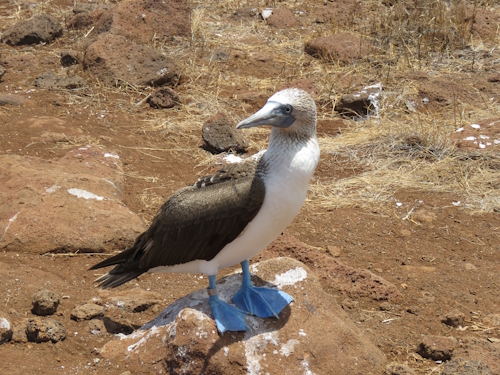
A closer look at the 12 that got inscribed
Ordered by official ID, which seems to have been handed out at the acceptance of the nomination dossier, the following sites were inscribed:
1 - Galapagos Islands (photo 3)
2 - Quito
3 - Aachen Cathedral
4 - L'Anse aux Meadows
9 - Simien National Park (photo 2)
18 - Lalibela
24 - Nahanni National Park
26 - Island of Gorée
27 - Mesa Verde
28 - Yellowstone
29 - Kraków
32 - Wieliczka Salt Mine
Some trivia:
- With an average rating of 4.08, according to our community, 1978 still represents the best year in WH history.
- Iain Jackson was and still is the only member to have visited all 12 WHS of 1978. At 11, Gary Arndt, Roger Ourset (both missing Simien NP), Michael Novins, Atila Ege, and Roman Bruehwiler (all missing Nahanni) came close. 10 more lack visits to 2 WHS.
- Only 7 different countries had sites inscribed; 5 of them had two sites. 36 countries had ratified the WH Convention at the time.
- No site in Asia was recognized. Also, Iran was the only WHC member representing that continent at the meeting.
Els - 9 March 2025
Comments
Els Slots 11 March 2025
Good point, Astraftis, regarding "Probably there was the tendency to favour "special" places beyond the most known ones, which was taken as granted and maybe not considered in need of immediate protection." - from what I read about 1978, there also was the appeal of getting a budget allocated (it may explain the actions of Ethiopia). Maybe I will do a follow-up post about the first 5-10 years, zooming in on that aspect.
Astraftis 10 March 2025
Very interesting! I love this history of WHS.
With regard to Clyde's question, beyond the bureaucratic reasons explained by Solivagant, I have the impression that at the time there seemed to be a slightly different idea about what needed to be nominated. Probably there was the tendency to favour "special" places beyond the most known ones, which was taken as granted and maybe not considered in need of immediate protection.
Val Camonica was enjoying some popularity in those years. Some years before, in 1975, the coat of arms (later also flag) of Lombardy was inspired by its rock art. This was probably due to the surge in their studies in the '60s. And so they landed on Italy's list as #1. Roman ruins and historical city centers are perhaps too obvious.
On the more futile side of things, I was thinking that we could assign ourselves some kind of number based on the codes of the first non-visited sites on the list... well, since I have never been to Americas, it is an easy 1-2-4, not really exciting.
Els Slots 10 March 2025
You're right about the numbers, Ian. They can be found here: https://whc.unesco.org/document/341
Ian Cade 10 March 2025
Thanks very much for this Els, a nice little deep dive.
It also helps explain something that has niggled me for ages, why are there no site numbers 5,6,7 (they must be the 3 Tunisian unsuccessful nominations) or 11 & 14 (which must be the 2 unsuccessful Ethiopian/ Eritrean nominations)
I'm sure the answer to that already existed somewhere on this site, but it eluded me until today.
Solivagant 9 March 2025
@Clyde "Any idea how come Italy and China had no site at the time?"
The World was very different 47 years ago at the time of the 1978 WHC
a. Italy didn't ratify the WH Convention until 23 Sept 1978 - after the Bureau meeting of that year. It did well to get Valcamonica nominated and inscribed the next year (1979) as its first WHS... an interesting choice, perhaps reflecting that it wanted something reasonably "simple" to start with? Rome waited until 1980.
b. China didn't ratify unti 12 Dec 1985!! I made my first visit to China in Jun 1978..... The Gang of Four had only been toppled in Oct 1976.... and the country was in a period of interregnum with Deng Xiaoping just reasserting himself under Huaguofeng ...but not yet in control.....and the rest is History!
clyde 9 March 2025
Interesting! Any idea how come Italy and China had no site at the time? 2 each were probably not enough...
Sebasfhb 9 March 2025
Great history! Nice to see my photograph still was of some use
Jay T 9 March 2025
Thanks for the deep dive on the first class of World Heritage Sites. They remain a goal of mine, and I'm hoping for some progress on more of them this year. I'm fascinated to see what was proposed so early on; I'd never looked up that history.
Blog WHS website
Plaque Project Update
Last October, we started the inventory of WHS Plaques, with many community members posting their info at the dedicated forum topic since. I'd like to give a big thanks to all who have contributed. Especially to Clyde, who is the go-to guy to answer the question “Where’s the plaque?” since he has been fascinated with them for a long time. About 70% of the WHS now have at least one plaque registered.
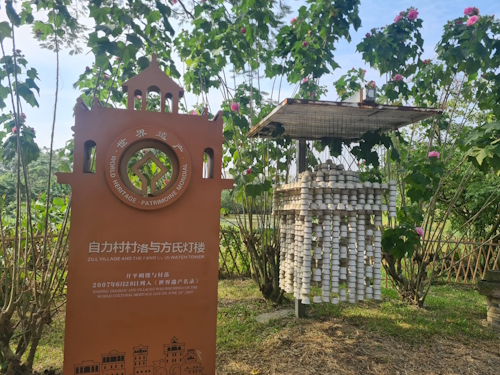
Findings from the first stage
A total of 1179 plaque locations have been put forward, spanning 851 sites. Over 1100 pictures of plaques were shared.
- We found out that some plaques that had been photographed previously are no longer present on site. So there is a Plaque History as well. I’ve added those older ones to the repository as well (with a remark) since they may have had interesting designs.
- When No Plaque has been found on a site, this is also logged.
- Some sites have dozens of small plaques, one for each monument. Here, I tried to follow the logic of making separate entries only when they are at official separate components.
- As always, when you’re taking on big projects, there’s a bycatch as well: this was really the first time that I used the location names in overview lists. Some were outdated or unnecessarily long, like “Canterbury Cathedral Canterbury, Kent”. In those cases, I updated the location names as well.
Incorporating them into the website
The full plaque overview can be found on this revised page: WHS Plaque Collection. When you click on a thumbnail picture in the list, you’ll get a larger version to view the plaque in more detail. I think it is great to browse through them and:
- find the pretty ones (the Val di Noto series, the Kaiping Diaolou (photo 1 above) and Pitons of Réunion (photo 3 below));
- or the ones with errors or misspellings (look at Mazagan, the Mausoleum of Khoja Ahmed Yasawi and Persepolis);
- or the ones in bad shape (such as the broken one at Awash) or still a work in progress (Gedeo, see photo 2);
- or the ones with interesting languages (the Tower of Hercules is in Latin, the Hoysala temple has writing in Kannada), or calendars (Koguryu Tombs displays the year of inscription in the Juche calendar).
The page lists all plaques suggested so far, but adding all available photos is still a work in progress. Both Solivagant and Clyde gave me access to hundreds from their private collections.
Also, there’s a block on each site page that displays the applicable plaque(s). This is a temporary solution – maybe they would be better stored in an album, but we don’t have the functionality for that at the moment.
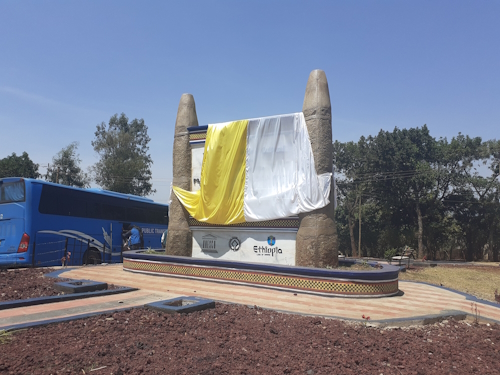
Photo policy
For the plaque photos the same photo policy is applicable as elsewhere on this website:
- The copyright of the photos stays with the original owner. The photo credit is shown.
- Photos taken by community members are preferred over those from the public domain.
Also, I have
- Chosen the clearest picture if we have more than one, preferably with the plaque being the center, with a little bit of the setting (on a wall, a stone, etc) showing. No people present.
- Stored the photos in a reusable way (standard naming and in 3 sizes).
- Watermarked the large pictures to discourage theft of this unique collection.
- Not used external sources such as Shutterstock and Alamy (as the unpaid versions are covered in watermarks) and sources that don't allow deeplinks.
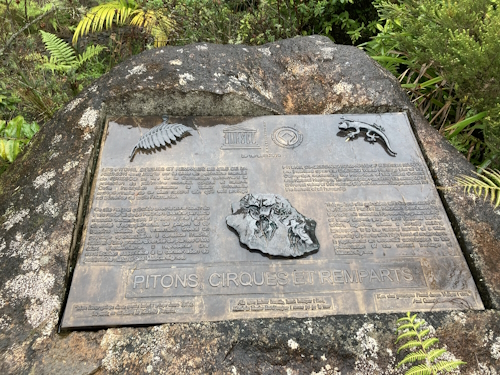
Things to do and how you can help
We’re not done yet! I will be adding the remaining photos that have already been delivered or suggested. There are still hundreds to go, so that will take me several weeks.
Where you can help is that we need plaque locations (and plaque photos) for the 372 missing WHS. I’ve put a list, ordered by country, of the missing ones on the Plaque Topic on the Forum. You can add the specifics there and/or send them by e-mail to els@worldheritagesite.org. Brazil, China, Germany, Indonesia, Iran, Kenya, Peru, Russia, South Africa, and Vietnam are countries that are especially underrepresented at the moment.
And if you have any photos of your own that could replace those now marked as coming from an “external source”, I’d also be grateful.
Els - 2 March 2025
Blog Index
Books
- Book: Seven Wonders (21 July 2024)
- Book: Saving Yellowstone (10 September 2023)
- Book: Natural Wonders of the World (30 July 2023)
- Book: Heaven on Earth (21 May 2023)
- Book: World Heritage Craze in China (26 March 2023)
- Possible Antarctic WHS (5 February 2023)
- Book: Cultural Heritage and Mass Atrocities (25 September 2022)
- Book: India: UNESCO World Heritage Sites (3 April 2022)
- Book: Great World Wonders (7 November 2021)
- Book: Chinese Heritage Sites and their Audiences (13 June 2021)
- Book: Coastal WHS (3 January 2021)
- Book: Atlas Obscura (10 February 2019)
- The Rebirth of Bodh Gaya (10 February 2018)
- Books: Modern African Architecture (18 February 2017)
- Books: Wonders of the World (28 November 2015)
- Book: Chasing 193 (8 July 2015)
- Book: The Heritage Universe (27 June 2015)
- Book: Japan's World Heritage Sites (26 October 2014)
Connections
- One Million - Updated (20 April 2025)
- A closer look at Rock Cut Art (6 April 2025)
- The Most Remote Cultural WHS (13 October 2024)
- The World’s Greatest Natural Areas (6 October 2024)
- Spice (Route(s)) WHS (18 August 2024)
- Connected (14 July 2024)
- Top Neolithic WHS (7 July 2024)
- Strict Nature Reserves (12 May 2024)
- Centres of Plant Diversity #2 (14 April 2024)
- Centres of Plant Diversity (17 March 2024)
- WHS in TCC Territories (25 February 2024)
- Gorilla (T)WHS (28 January 2024)
- Foreigner Pricing Analysis (14 January 2024)
- Best Visited on a Bicycle (19 November 2023)
- Minor Boundary Modifications (29 October 2023)
- Smaller than they seem (20 August 2023)
- Himalaya (4 June 2023)
- One thousand visitors or fewer (23 April 2023)
- Canopy Walkways (2 April 2023)
- Invention of sweets and pastries (22 January 2023)
- Transnational WHS in the making (16 October 2022)
- Obelisks (21 August 2022)
- Threatened by Oil and Gas Exploration (7 August 2022)
- Byzantine (24 July 2022)
- Critically endangered fauna species (12 June 2022)
- Petrosomatoglyphs (1 May 2022)
- Fossil sites (17 April 2022)
- Cable cars (27 March 2022)
- Erotic Art (19 December 2021)
- Silk Road(s) (14 November 2021)
- Diluted by an Extension (31 October 2021)
- WHS and Beer (12 September 2021)
- Buildable in Lego (22 August 2021)
- WHS Hotspots (15 August 2021)
- WHS affected by Poaching (2 May 2021)
- Epic Subtitles (7 March 2021)
- No Road Access (28 February 2021)
- Expressionist Architecture (17 January 2021)
- Cold War (20 December 2020)
- Dependent Territories (29 November 2020)
- Mammal WHS (15 November 2020)
- Bird Migration WHS (24 May 2020)
- WHS in classic documentaries (12 April 2020)
- Unusual Entry Requirements (29 March 2020)
- WH Travel & Passports (1 December 2019)
- Railway WHS (1 September 2019)
- Why people die at WHS (21 April 2019)
- The Umayyads (17 March 2019)
- Historical Graffiti (3 March 2019)
- Viewable from another WHS (9 June 2018)
- One million or more (3 March 2018)
- WHS On Banknotes (16 December 2017)
- A Silk Roads overdose? (20 November 2016)
- A History of WHS in Danger (5 September 2015)
- WHS & World War I (19 October 2014)
Countries
- Top Tips for Travelling to Iraq (4 May 2025)
- Most Difficult Countries to visit a WHS in (23 February 2025)
- Top Tips for Senegal and The Gambia (26 January 2025)
- Top Tips for India (15 December 2024)
- Top Tips for the wider Veneto Hotspot (20 October 2024)
- Top Tips for Japan (29 September 2024)
- Completing Norway (30 June 2024)
- Top Tips for Travelling to Kazakhstan (16 June 2024)
- Top Tips for 15 days in China (2 June 2024)
- Top Tips for Pakistan (24 December 2023)
- Top Tips for Saudi Arabia (3 December 2023)
- Top Tips for Zimbabwe (1 October 2023)
- Top Tips for Madagascar (9 July 2023)
- Tips for Travelling to Western Turkey (14 May 2023)
- Tips for Travelling to Northern Brazil (8 January 2023)
- Tips for Travelling to Chad (20 November 2022)
- Top Tips for Eastern Canada (10 July 2022)
- Top Tips for Tunisia (29 May 2022)
- Top Tips for Northern Mexico (27 February 2022)
- Best Countries (23 January 2022)
- Tips for travelling to Kyrgyzstan (17 October 2021)
- Tips for travelling to Costa Rica (25 April 2021)
- Tips for travelling during a pandemic (14 March 2021)
- Tips for travelling to Iceland (20 September 2020)
- Tips for travelling to Colombia (16 February 2020)
- Tips for travelling to Russia (27 October 2019)
- Tips for travelling to Georgia (4 August 2018)
- Tips for travelling to the Gulf (2 May 2018)
- Value for money WH countries (24 March 2018)
- Tips for travelling to Namibia (3 February 2018)
- Tips for travelling to Ecuador (14 October 2017)
- Tips for travelling to Egypt (30 April 2017)
- Tips for Azerbaijan and Iran (3 June 2016)
- Tips for Rwanda, Congo and Uganda (30 January 2016)
- Tips for Travelling to Myanmar (31 October 2015)
- Mongolia's Tentative List (28 February 2015)
- How to visit the (T)WHS of Sudan (22 November 2014)
Exhibitions
- Unveiling the Stoclet House (7 April 2024)
- Rietveld Bike Tour (26 November 2017)
- Looking for the Golden Rhino (4 December 2016)
- Vestfold Ship Burials (18 June 2016)
- Rome. Emperor Constantine’s dream. (22 November 2015)
- Carthage (8 March 2015)
TWHS Visits
- Old City of Mosul (27 April 2025)
- 2025 WHC: Carnac (23 March 2025)
- Workers' Assembly Halls (Belgium) (10 November 2024)
- Sites of the Busan Wartime Capital (1 September 2024)
- San Pedro de Atacama (24 March 2024)
- Fell and Pali Aike Caves (10 March 2024)
- The Underwater City of Port Royal (18 February 2024)
- Uch Sharif (17 December 2023)
- Hejaz Railway (26 November 2023)
- WHC 2023: Kuldīga (6 August 2023)
- Gordion (7 May 2023)
- Íznik (30 April 2023)
- Niah Caves (19 March 2023)
- Banteay Chhmar (19 February 2023)
- Via Appia (30 October 2022)
- Valentia's Transatlantic Cable Ensemble (23 October 2022)
- Civita di Bagnoregio (9 October 2022)
- Zagori & Pindos (11 September 2022)
- Talayotic Minorca (21 November 2021)
- Kyrgyz Silk Roads: Uzgen (10 October 2021)
- Historic Center of Parma (29 August 2021)
- Bachkovo Monastery (18 July 2021)
- Mosaics of Philippopolis (11 July 2021)
- Prince-Bishops' Palace in Liège (20 June 2021)
- Lower German Limes: Berg en Dal Aqueduct (30 May 2021)
- Corcovado NP (11 April 2021)
- Guayabo National Monument (24 March 2021)
- San José (21 March 2021)
- Buenos Aires 1880-1920 (21 February 2021)
- The Egyptian Museum (14 February 2021)
- The Meuse Citadel of Namur (7 February 2021)
- The Neanderthal fossil sites of Wallonia (24 January 2021)
- Plantations in West Curacao (13 December 2020)
- Unreviewed TWHS: Hirkan Forests (22 November 2020)
- Sanxingdui in 2007 (8 November 2020)
- Archipelago of La Maddalena (25 October 2020)
- Bouches de Bonifacio (18 October 2020)
- Nice (4 October 2020)
- Mediterranean Alps (27 September 2020)
- Icelandic Turf House Tradition (13 September 2020)
- Mývatn and Laxá (30 August 2020)
- Fjallabak (23 August 2020)
- Old Wastewater Treatment Plant (16 August 2020)
- Mértola (5 August 2020)
- Vila Viçosa (2 August 2020)
- Works of Álvaro Siza (19 July 2020)
- Great Spas: Bad Ems (28 June 2020)
- ShUM city of Worms (21 June 2020)
- Chapultepec (7 June 2020)
- Frederiksoord-Wilhelminaoord (17 May 2020)
- Tuol Sleng Genocide Museum (3 May 2020)
- Unreviewed TWHS: Lalish Temple (26 April 2020)
- Unreviewed TWHS: Bahoutdin Complex (5 April 2020)
- New Dutch Waterline (22 March 2020)
- WHC 2021: The Slate Landscape (15 March 2020)
- Unreviewed TWHS: Tansen (8 March 2020)
- Sarlat at Night (1 March 2020)
- Salt Town of Nemocón (5 January 2020)
- Virgilio Barco Library (29 December 2019)
- Irkutsk (20 October 2019)
- Staigue Stone Fort (25 August 2019)
- The Royal Sites of Ireland: Cashel (18 August 2019)
- Hospital of Our Lady with the Rose (11 August 2019)
- WHC 2019: Krzemionki (30 June 2019)
- Chobe (2 June 2019)
- WHC 2021: Sarnath (5 May 2019)
- Olive Grove Landscape of Lucena (14 April 2019)
- Lower German Limes: Xanten (31 March 2019)
- Harran and Sanliurfa (24 March 2019)
- Padova Urbs Picta (10 March 2019)
- WHC 2019: Paraty Culture and Biodiversity (24 February 2019)
- WHC 2019: Walled City of Jaipur (17 February 2019)
- Ancient Quanzhou (26 January 2019)
- Yen Tu: Vinh Nghiem Pagoda (5 January 2019)
- Roman heritage of Nîmes (1 December 2018)
- Raoudha Nilometer (24 November 2018)
- WHC 2019: Danube Limes - Arrianis (31 October 2018)
- Uplistsikhe Cave Town (21 July 2018)
- Tbilisi Historic District (14 July 2018)
- David Gareji Monasteries (23 June 2018)
- Fortress of Ananuri (16 June 2018)
- Gdansk - Town of Memory and Freedom (2 June 2018)
- WHC 2018: Žatec, Town of Hops (12 May 2018)
- Ore Mountains (5 May 2018)
- Dubai Creek (28 April 2018)
- Sharjah: the Gate to Trucial States (18 April 2018)
- Forts of Rostaq and al-Hazm (4 April 2018)
- Kuwait Towers (31 March 2017)
- Teylers (17 March 2018)
- WHC 2019: Plečnik in Ljubljana (17 February 2018)
- Etosha Pan (10 January 2018)
- Benguela Current (5 January 2018)
- Fish River Canyon (1 January 2018)
- Lechner's pre-modern architecture (9 December 2017)
- WHC 2018: Chaîne des Puys (18 November 2017)
- Hoge Kempen Transition Landscape (21 October 2017)
- Mathildenhöhe (19 August 2017)
- Mid-Atlantic Ridge (6 July 2017)
- Ptolemaic Temples (21 April 2017)
- WHC 2017: Dilmun Burial Mounds (11 February 2017)
- Palau and the Yapese Stone Money (7 January 2017)
- Tet el Bad (Stone Coffin) (1 January 2017)
- Hanyangdoseong (29 December 2016)
- Zadar - Romans and Venetians (12 November 2016)
- Nelson Mandela Legacy Sites (19 October 2016)
- Ngwenya Mines (12 October 2016)
- 1940's - 1950's Architecture of Minsk (7 September 2016)
- 20th Century Ivrea (13 August 2016)
- Waterloo (30 July 2016)
- Agricultural Pauper Colonies (9 July 2016)
- Masouleh (25 May 2016)
- Sheki, the Khan's Palace (2 May 2016)
- Temple of Fire (24 April 2016)
- Fortress Town of Palmanova (12 March 2016)
- WHC 2016: Rediscovering Dosan Seowon (13 February 2016)
- WHC 2016 – Corbusier’s Villa Savoye (7 February 2016)
- Mgahinga – Where Gold Meets Silver (9 January 2016)
- Rwandan Genocide Memorial Sites (29 December 2015)
- WHC 2016: Cetinje (5 December 2015)
- WHC 2016: Ani Cultural Landscape (13 November 2015)
- Sonian Forest’s Beech Cathedral (7 November 2015)
- Ancient cities of Upper Myanmar (24 October 2015)
- Bagan Archaeological Zone (17 October 2015)
- Konbaung Wooden Monasteries (9 October 2015)
- WHC 2015: Christiansfeld (20 June 2015)
- The Mystery of Kokino (14 June 2015)
- Amphitheatre of Durres (3 June 2015)
- WHC 2015: Champagne (14 May 2015)
- WHC 2015: Palermo, Cefalù & Monreale (9 May 2015)
- Two TWHS in Antwerp (6 April 2015)
- Five Dzongs of Bhutan (14 March 2015)
- Granada and its natural environment (20 February 2015)
- Volcan Masaya - Exciting or not? (14 February 2015)
- WHC 2015: Singapore Botanic Gardens (20 December 2014)
- Old Dongola (1 December 2014)
- Great Spas of Europe: the original Spa (15 November 2014)
- WHC 2015: Hagi Castle Town (9 November 2014)
Travel in general
- Travel Windows of Opportunity (30 March 2025)
- Trip Budgeting (31 March 2024)
- Parallel planning of multiple trips (27 August 2023)
- My experience travelling ultra-light (20 March 2022)
WH Travellers
- Tours to WHS (9 February 2025)
- TWHS Masters (2 February 2025)
- The Quest for 1,100 visited WHS - Year 3 (5 January 2025)
- Drive-by Visits (22 December 2024)
- Maddeningly Close (3 November 2024)
- WHS-ers do Tassel (4 August 2024)
- Getting a Stoclet Pass (23 June 2024)
- Learning from the Birders (28 April 2024)
- Completing Countries (4 February 2024)
- The Quest for 1,100 visited WHS - Year 2 (7 January 2024)
- The Value of a TWHS (16 July 2023)
- The 9 WHS Commandments (5 March 2023)
- Nine things I learned in my first year of full-time travel (1 January 2023)
- Revisit needed (27 November 2022)
- Shandos ... planning a WH trip to South America (2 October 2022)
- Michael Ayers ... cycling to over 300 WHS (5 June 2022)
- WH Travel Focus (10 April 2022)
- The quest to 1100 visited WHS in 2030 (2 January 2021)
- Wojciech and Thomas ... In Iraq (28 November 2021)
- Zos M. ... Completing China (24 October 2021)
WHS Visits
- WHS #958: Umm Al-Jimāl (13 April 2025)
- WHS #957: Djerba (16 March 2025)
- WHS #956: Cidade Velha (16 February 2025)
- WHS #951: Saloum Delta (19 January 2025)
- WHS #946: Banc d'Arguin (12 January 2025)
- WHS #941: Mahabodhi Temple (8 December 2024)
- WHS #939: Kaziranga (1 December 2024)
- WHS #936: Indian Sundarbans (24 November 2024)
- WHS #932: Champaner-Pavagadh (17 November 2024)
- WHS #926: Ogasawara Islands (22 September 2024)
- WHS #925: Sado Gold Mines (15 September 2024)
- WHS #924: Shiretoko (8 September 2024)
- WHS #909: Tanbaly (9 June 2024)
- WHS #904: China Danxia (26 May 2024)
- WHS #903: Mount Wuyi (19 May 2024)
- My #900: Roșia Montană (21 April 2024)
- WHS #894: Los Alerces National Park (3 March 2024)
- WHS #886: Sangha! (21 January 2024)
- WHS #880: Makli, Thatta (10 December 2023)
- WHS #875: Erfurt (5 November 2023)
- (T)WHS of New York City (22 October 2023)
- WHS #872: Poverty Point (15 October 2023)
- Chicago Meetup (8 October 2023)
- WHS #850: Mana Pools (17 September 2023)
- WHS #848: Great Zimbabwe (3 September 2023)
- WHS #846: Tsingy de Bemaraha (2 July 2023)
- WHS #845: Royal Hill of Ambohimanga (25 June 2023)
- WHS #844: Rainforests of the Atsinanana (18 June 2023)
- WHS #843: Pitons of Reunion (11 June 2023)
- Kraków revisited (9 April 2023)
- WHS #833: Gunung Mulu (12 March 2023)
- WHS #831: Kui Buri NP (26 February 2023)
- WHS #827: Sambor Prei Kuk (12 February 2023)
- WHS #825: Mazagan (29 January 2023)
- WHS #813: Fernando de Noronha (18 December 2022)
- WHS #812: São Luis (11 December 2022)
- WHS #811: Central Amazon (4 December 2022)
- WHS #810: Ounianga Lakes (13 November 2022)
- WHS #809: Ennedi (6 November 2022)
- WHS #807: Island of Patmos (18 September 2022)
- WHS #804: Mount Athos (4 September 2022)
- Skellig Michael 2022 (14 August 2022)
- WHS #800: Red Bay (3 July 2022)
- WHS #798: Mistaken Point (26 June 2022)
- WHS #797: Gros Morne NP (19 June 2022)
- WHS #789: Kairouan (22 May 2022)
- WHS #786: Carthage (15 May 2022)
- WHS #783: Lake District (24 April 2022)
- WHS #780: Quirigua (13 March 2022)
- WHS #778: Joya de Ceren (6 March 2022)
- WHS #774: Sierra de San Francisco (20 February 2022)
- WHS #773: El Vizcaíno (13 February 2022)
- WHS #771: EPGDABR (6 February 2022)
- WHS #766: Otumba (30 January 2022)
- WHS #765: Paquimé (16 January 2022)
- Luxembourg revisited (9 January 2022)
- WHS #764: Serra de Tramuntana (5 December 2021)
- WHS #763: Sulaiman-Too (3 October 2021)
- WHS #762: Western Tien-Shan (26 September 2021)
- Silk Roads: Zhetysu region (19 September 2021)
- WHS #761: Bologna (5 September 2021)
- WHS #760: Cordouan Lighthouse (8 August 2021)
- WHS #747: The Prosecco Hills (25 July 2021)
- WHS #746: Kazanlak (4 July 2021)
- WHS #745: Pirin National Park (27 June 2021)
- Wadden Sea: Schiermonnikoog (16 May 2021)
- WHS #744: Guanacaste (18 April 2021)
- WHS #743: Stone Spheres (4 April 2021)
- WHS #742: Talamanca Range (28 March 2021)
- Wadden Sea: Texel (10 January 2020)
- WHS #741: Willemstad (6 December 2020)
- WHS #740: Su Nuraxi di Barumini (1 November 2020)
- WHS #739: Gulf of Porto (11 October 2020)
- WHS #738: Surtsey (6 September 2020)
- WHS #737: Thingvellir (2 September 2020)
- WHS #736: Vatnajökull (26 August 2020)
- WHS #735: Kladruby nad Labem (9 August 2020)
- WHS #734: Bom Jesus do Monte (26 July 2020)
- WHS #733: Mafra (12 July 2020)
- Cologne revisited (14 June 2020)
- Aachen revisited (31 May 2020)
- WHS #732: Vézère Valley (23 February 2020)
- WHS #731: Cartagena de Indias (9 February 2020)
- WHS #730: Mompox (2 February 2020)
- WHS #729: Coffee Cultural Landscape (26 January 2020)
- WHS #728: Tierradentro (19 January 2020)
- WHS #727: San Agustín (12 January 2020)
- WHS #726: St. George, Bermuda (24 November 2019)
- WHS #725: Augsburg (17 November 2019)
- Val di Noto - Catania (10 November 2019)
- WHS #724: Mount Etna (3 November 2019)
- WHS #723: Lake Baikal (13 October 2019)
- WHS #722: Sviyazhsk (6 October 2019)
- WHS #721: Bolgar (29 September 2019)
- WHS #720: Kazan Kremlin (22 September 2019)
- WHS #719: Trinity Sergius Lavra (15 September 2019)
- WHS #718: Church of the Ascension (8 september 2019)
- WHS #706: Tokaj Wine Region (28 juli 2019)
- WHS #705: Hortobagy NP (21 July 2019)
- WHS #704: Hollókő (14 July 2019)
- WHS #703: Bialowieza Forest (23 June 2019)
- WHS #702: Zamość (16 June 2019)
- WHS #701: Victoria Falls (9 June 2019)
- WHS #700: Okavango Delta (28 May 2019)
- WHS #699: Tsodilo (19 May 2019)
- WHS #698: Naumburg Cathedral (28 April 2019)
- WHS #697: Medina Azahara (7 April 2019)
- WHS #696: Fujian Tulou (2 February 2019)
- WHS #695: Kulangsu (19 January 2019)
- WHS #694: Hani Rice Terraces (16 January 2019)
- WHS #693: Chengjiang Fossil Site (12 January 2019)
- WHS #692: Zuojiang Huashan (9 January 2019)
- WHS #691: Ho Citadel (2 January 2019)
- WHS #690: Trang An (29 December 2018)
- Hôtel Solvay (15 December 2018)
- WHS #689: Cave of Pont d'Arc (8 December 2018)
- WHS #688: Wadi al-Hitan (17 November 2018)
- WHS #687: Historic Cairo (10 November 2018)
- WHS #686: the Pyramid Fields (3 November 2018)
- WHS #685: Valtice (27 October 2018)
- WHS #684: Kromeriz (24 October 2018)
- WHS #683: Litomysl Castle (21 October 2018)
- Athens Acropolis revisited (17 October 2018)
- WHS #682: Daphni Monastery (13 October 2018)
- WHS #681: Meteora (9 October 2018)
- WHS #680: Philippi (6 October 2018)
- WHS #679: Bursa (29 September 2018)
- Istanbul revisited (26 September 2018)
- WHS #678: Nessebar (22 September 2018)
- WHS #677: Srebarna (19 September 2018)
- WHS #676: Churches of Ivanovo (15 September 2018)
- WHS #675: Tomb of Sveshtari (12 September 2018)
- WHS #674: Madara Rider (8 September 2018)
- WHS #673: Geirangerfjord (26 August 2018)
- WHS #672: Alta Rock Art (18 August 2018)
- WHS #671: Visby (28 July 2018)
- WHS #664: Gelati Monastery (7 July 2018)
- WHS #665: Qalhat (1 July 2018)
- WHS #663: Upper Svaneti (27 June 2018)
- WHS #662: Mtskheta (20 June 2018)
- WHS #661: Malbork Castle (26 May 2018)
- WHS #660: Torun (19 May 2018)
- WHS #659: Cultural Sites of Al Ain (25 April 2018)
- WHS #658: Land of Frankincense (21 April 2018)
- WHS #657: Bat and Al-Ayn (14 April 2018)
- WHS #656: Bahla Fort (11 April 2018)
- WHS #655: Aflaj of Oman (7 April 2018)
- WHS #654: Ibiza (25 February 2018)
- WHS #653: Robben Island (22 January 2018)
- WHS #652: Cape Floral Region (19 January 2018)
- WHS #651: Twyfelfontein (15 January 2018)
- WHS #650: Namib Sand Sea (12 January 2018)
- WHS #649: Pécs Necropolis (3 December 2017)
- WHS #648: Saint-Savin sur Gartempe (11 November 2017)
- WHS #647: Bourges Cathedral (4 November 2017)
- WHS #646: Galapagos Islands (7 October 2017)
- WHS #645: Quito (30 September 2017)
- WHS #644: Sangay NP (26 September 2017)
- Ingapirca (22 September 2017)
- WHS #643: Cuenca (19 September 2017)
- WHS #642: Antequera Dolmens (16 September 2017)
- WHS #641: Tetouan (13 September 2017)
- WHS #640: Gorham's Cave (10 September 2017)
- WHS #639: Neolithic Orkney (27 August 2017)
- WHS #638: Ice Age Art Caves (13 August 2017)
- WHS #637: Røros (30 July 2017)
- WHS #635: Pico Island (15 July 2017)
- WHS #634: Angra do Heroismo (1 July 2017)
- Wooden tserkva of Zhovkva (10 June 2017)
- WHS #633: L'viv (4 June 2017)
- WHS #632: Telc (20 May 2017)
- WHS #631: Cesky Krumlov (13 May 2017)
- WHS #630: Holasovice (6 May 2017)
- WHS #629: Nubian monuments (26 April 2017)
- WHS #628: Ancient Thebes (16 April 2017)
- Paris revisited (27 March 2017)
- WHS #627: Salins-les-Bains (11 March 2017)
- WHS #626: Beaune (Burgundy) (4 March 2017)
- WHS #625: Par force hunting landscape (4 February 2017)
- WHS #624: Royal Joseon Tombs (21 January 2017)
- WHS #623: Baekje sites in Gongju (14 January 2017)
- WHS #622: Namhansanseong (11 January 2017)
- WHS #621: Rock Islands (4 January 2017)
- Westminster Abbey (10 December 2016)
- WHS #620: Plitvice Lakes (5 November 2016)
- WHS #619: Vredefort Dome (29 October 2016)
- WHS #618: Drakensberg (22 October 2016)
- WHS #617: iSimangaliso Wetland (15 October 2016)
- WHS #616: Mapungubwe (8 October 2016)
- WHS #615: Makapan Fossil Hominid Site (3 October 2016)
- WHS #614: Nesvizh (17 Sept 2016)
- WHS #613: Mir Castle (10 September 2016)
- WHS #612: Kernavė (3 september 2016)
- WHS #611: Curonian Spit (26 August 2016)
- Palazzina di Stupinigi (20 August 2016)
- WHS #610: Piedmont Vineyards (6 August 2016)
- WHS #606: Reichenau (2 July 2016)
- WHS #605: Swiss Alps (25 June 2016)
- WHS #604: Rjukan / Notodden (10 June 2016)
- WHS #603: Golestan Palace (28 May 2016)
- WHS #602: Soltaniyeh (21 May 2016)
- WHS #601: Takht-e Soleyman (18 May 2016)
- WHS #600: Armenian Monastic Ensembles (14 May 2016)
- WHS #599: Tabriz Bazaar (11 May 2016)
- WHS #598: Safi al-Din Ensemble (8 May 2016)
- WHS #597: Gobustan Rock Art (5 May 2016)
- WHS #596: Walled City of Baku (29 April 2016)
- A Rainy Day in Oporto (16 April 2016)
- WHS #595: Rock Art of the Coa Valley (2 April 2016)
- WHS #594: Santiago de Compostela (26 March 2016)
- Another piece of the Longobard puzzle (5 March 2016)
- Venice in one day (27 February 2016)
- WHS #593: Aquileia (21 February 2016)
- WHS #592: Kasubi Tombs (24 January 2016)
- WHS #591: Rwenzori Mountains (20 January 2016)
- WHS #590: Bwindi (15 January 2016)
- WHS #589: Virunga! (4 January 2016)
- A second look at Edinburgh (19 December 2015)
- WHS #588: Forth Bridge (13 December 2015)
- WHS #587: Pyu City of Halin (3 October 2015)
- WHS #586: Wachau (19 September 2015)
- WHS #585: Neusiedlersee (13 September 2015)
- WHS #584: Gammelstad (19 August 2015)
- WHS #583: Laponia (15 August 2015)
- Searching for the Wadden Sea (8 August 2015)
- WHS #582: Wooden Tserkvas (1 August 2015)
- WHS #581: Malopolska Churches (25 July 2015)
- WHS #580: Auschwitz Birkenau (19 July 2015)
- WHS #570: Medieval Monuments in Kosovo (10 June 2015)
- WHS #569: Ohrid Region (6 June 2015)
- WHS #568: Berat and Gjirokaster (30 May 2015)
- WHS #567: Butrint (27 May 2015)
- WHS #566: Corfu Old Town (24 May 2015)
- WHS #565: Vézelay (20 May 2015)
- WHS #564: Cistercian Abbey of Fontenay (17 May 2015)
- Remembering the Kathmandu Valley (3 May 2015)
- Florence in-depth (27 April 2015)
- WHS #563: Medici Villas and Gardens (21 April 2015)
- WHS #562: A Mining Landscape (25 March 2015)
- WHS #561: León Cathedral (6 February 2015)
- WHS #560: Ruins of León Viejo (31 January 2015)
- WHS #559: Portobelo (24 January 2015)
- WHS #558: Panamá (18 January 2015)
- WHS #557: San Cristobal de La Laguna (10 January 2015)
- WHS #556: Teide National Park (3 January 2015)
- WHS #555: Gomera's Garajonay (29 December 2014)
- WHS #554: Magnificent Meroë (13 december 2014)
- WHS #553: Gebel Barkal (7 December 2014)
- WHS #552: The Two Faces of Corvey (2 November 2014)
WHS website
- The First List (9 March 2025)
- Plaque Project Update (2 March 2025)
- 2024 - A Year in Review(s) (29 December 2024)
- Best Recent WHS (27 October 2024)
- Country Statistics (25 August 2024)
- Long-term trends (11 August 2024)
- 10 Bits of Trivia about the WHS of 2024 (28 July 2024)
- Predicting new nominations (5 May 2024)
- More Stats! (11 February 2024)
- 2023 - A Year in Review(s) (31 December 2023)
- Things I learned from rewriting the site intros (12 November 2023)
- 10 Bits of Trivia about the WHS of 2022/2023 (24 September 2023)
- Incomplete Dossiers (13 August 2023)
- The WHS Commandments pt.2 (23 July 2023)
- The 10,000th Review (28 May 2023)
- Aspiring TWHS (16 April 2023)
- WHS In the News (15 January 2023)
- 2022 - A Year in Review(s) (25 December 2022)
- Country pages (28 August 2022)
- Perfect Inscriptions (31 July 2022)
- WHS tracking apps (17 July 2022)
- Spring Cleaning (8 May 2022)
- 2021 - A Year in Review(s) (26 December 2021)
- Resources about WHS (12 December 2021)
- 10 Bits of Trivia about the WHS of 2020/2021 (1 August 2021)
- The Global Strategy in 2021 (6 June 2021)
- TWHS project: the wrap-up (23 May 2021)
- WHS Plaques and Certificates (9 May 2021)
- Pimping the TWHS pages (31 January 2021)
- 2020 - A Year in Review(s) (27 December 2020)
- Looking ahead to 2021 (5 July 2020)
- Taking Travel Risks (10 May 2020)
- Remembering Iain Jackson (18 April 2020)
- 2019 - A Year in Review(s) (22 December 2019)
- A free course in World Heritage (8 December 2019)
- WH Travellers meeting 2019 (4 August 2019)
- 10 Bits of Trivia about the WHS of 2019 (7 July 2019)
- Debunking travel blog myths (12 May 2019)
- Leftovers (22 December 2018)
- Official websites of WHS (11 August 2018)
- An improved website (27 January 2018)
- 2017 - A Year in Review(s) (23 December 2017)
- Favourite entrance tickets to WHS (28 October 2017)
- Completing Europe (27 January 2017)
- WH Trip Planning in 5 steps (21 December 2016)
- WH Travellers meeting in Vilnius (31 August 2016)
- 10 Bits of Trivia about the WHS of 2016 (23 July 2016)
- WHS Top 200: The Results (9 April 2016)
- What counts as a visit? (19 March 2016)
- One of our Missing: Shwedagon Pagoda (27 September 2015)
- WH Travellers meeting in Rotterdam (26 August 2015)
- A 17-Year Journey (12 October 2014)
